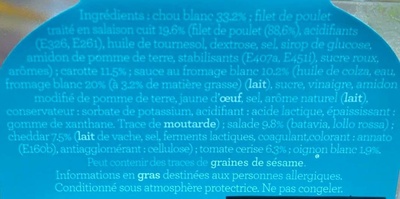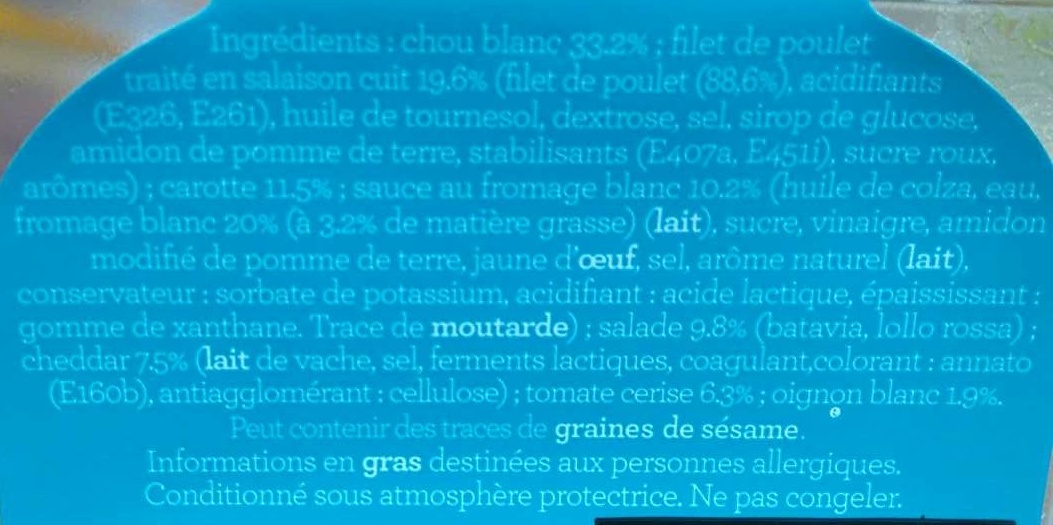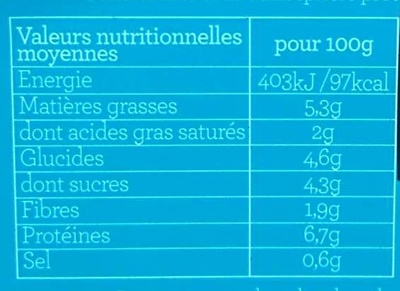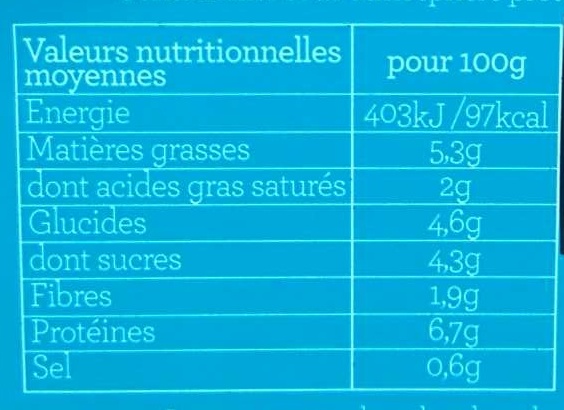Help us make food transparency the norm!
As a non-profit organization, we depend on your donations to continue informing consumers around the world about what they eat.
The food revolution starts with you!
Salade chicken coleslaw - McDonald's - 255 g
Salade chicken coleslaw - McDonald's - 255 g
This product page is not complete. You can help to complete it by editing it and adding more data from the photos we have, or by taking more photos using the app for Android or iPhone/iPad. Thank you!
×
Common name: Salade composée d'un mélange d'émincé de chou blanc, carotte râpée et d'oignon blanc avec une sauce au fromage blanc, de salade, de morceaux de filet de poulet saumuré rôti, de cheddar et de tomate cerise.
Quantity: 255 g
Brands: McDonald's
Categories: Meats and their products, Meals, Prepared salads, Meals with meat, Poultry meals, Meals with chicken, Vegetable salads, Salads
Manufacturing or processing places: France
Stores: McDonald's
Countries where sold: France
Matching with your preferences
Health
Ingredients
-
50 ingredients
: Chou blanc 33.2% ; filet de poulet traité en salaison cuit 19.6% (filet de poulet (88.6%), acidifiants (E326, E261), huile de tournesol, dextrose, sel, sirop de glucose, amidon de pomme de terre, stabilisants (E407a, E451i), sucre roux, arômes) ; carotte 11.5% ; sauce au fromage blanc 10.2% (huile de colza, eau, fromage blanc 20% (à 3.2% de matière grasse) (lait), sucre, vinaigre, amidon modifié de pomme de terre, jaune d’œuf, sel, arôme naturel (lait), conservateur : sorbate de potassium, acidifiant : acide lactique, épaississant : gomme de xanthane. Trace de moutarde) ; salade 9.8% (batavia, lollo rossa) ; cheddar 7.5% (lait de vache, sel, ferments lactiques, coagulant, colorant : annato (E160b), antiagglomérant : cellulose), tomate cerise 6.3% ; oignon blanc 1.9%.Allergens: Eggs, Milk, MustardTraces: Milk, Mustard, Sesame seeds
Food processing
-
Ultra processed foods
Elements that indicate the product is in the 4 - Ultra processed food and drink products group:
- Additive: E14XX - Modified Starch
- Additive: E160b - Annatto
- Additive: E326 - Potassium lactate
- Additive: E407a - Processed eucheuma seaweed
- Additive: E415 - Xanthan gum
- Additive: E451 - Triphosphates
- Additive: E460 - Cellulose
- Ingredient: Colour
- Ingredient: Dextrose
- Ingredient: Flavouring
- Ingredient: Glucose
- Ingredient: Glucose syrup
- Ingredient: Thickener
Food products are classified into 4 groups according to their degree of processing:
- Unprocessed or minimally processed foods
- Processed culinary ingredients
- Processed foods
- Ultra processed foods
The determination of the group is based on the category of the product and on the ingredients it contains.
Additives
-
E202 - Potassium sorbate
Potassium sorbate (E202) is a synthetic food preservative commonly used to extend the shelf life of various food products.
It works by inhibiting the growth of molds, yeast, and some bacteria, preventing spoilage. When added to foods, it helps maintain their freshness and quality.
Some studies have shown that when combined with nitrites, potassium sorbate have genotoxic activity in vitro. However, potassium sorbate is generally recognized as safe (GRAS) by regulatory authorities.
-
E261 - Potassium acetate
Potassium acetate: Potassium acetate -KCH3COO- is the potassium salt of acetic acid.Source: Wikipedia
-
E270 - Lactic acid
Lactic acid: Lactic acid is an organic compound with the formula CH3CH-OH-COOH. In its solid state, it is white and water-soluble. In its liquid state, it is colorless. It is produced both naturally and synthetically. With a hydroxyl group adjacent to the carboxyl group, lactic acid is classified as an alpha-hydroxy acid -AHA-. In the form of its conjugate base called lactate, it plays a role in several biochemical processes. In solution, it can ionize a proton from the carboxyl group, producing the lactate ion CH3CH-OH-CO−2. Compared to acetic acid, its pKa is 1 unit less, meaning lactic acid deprotonates ten times more easily than acetic acid does. This higher acidity is the consequence of the intramolecular hydrogen bonding between the α-hydroxyl and the carboxylate group. Lactic acid is chiral, consisting of two optical isomers. One is known as L--+--lactic acid or -S--lactic acid and the other, its mirror image, is D--−--lactic acid or -R--lactic acid. A mixture of the two in equal amounts is called DL-lactic acid, or racemic lactic acid. Lactic acid is hygroscopic. DL-lactic acid is miscible with water and with ethanol above its melting point which is around 17 or 18 °C. D-lactic acid and L-lactic acid have a higher melting point. In animals, L-lactate is constantly produced from pyruvate via the enzyme lactate dehydrogenase -LDH- in a process of fermentation during normal metabolism and exercise. It does not increase in concentration until the rate of lactate production exceeds the rate of lactate removal, which is governed by a number of factors, including monocarboxylate transporters, concentration and isoform of LDH, and oxidative capacity of tissues. The concentration of blood lactate is usually 1–2 mM at rest, but can rise to over 20 mM during intense exertion and as high as 25 mM afterward. In addition to other biological roles, L-lactic acid is the primary endogenous agonist of hydroxycarboxylic acid receptor 1 -HCA1-, which is a Gi/o-coupled G protein-coupled receptor -GPCR-.In industry, lactic acid fermentation is performed by lactic acid bacteria, which convert simple carbohydrates such as glucose, sucrose, or galactose to lactic acid. These bacteria can also grow in the mouth; the acid they produce is responsible for the tooth decay known as caries. In medicine, lactate is one of the main components of lactated Ringer's solution and Hartmann's solution. These intravenous fluids consist of sodium and potassium cations along with lactate and chloride anions in solution with distilled water, generally in concentrations isotonic with human blood. It is most commonly used for fluid resuscitation after blood loss due to trauma, surgery, or burns.Source: Wikipedia
-
E326 - Potassium lactate
Potassium lactate: Potassium lactate is a compound with formula KC3H5O3, or H3C-CHOH-COOK. It is the potassium salt of lactic acid. It is produced by neutralizing lactic acid which is fermented from a sugar source. It has E number "E326". Potassium lactate is a liquid product that is usually 60% solids but is available at up to 78% solids.Potassium lactate is commonly used in meat and poultry products to extend shelf life and increase food safety as it has a broad antimicrobial action and is effective at inhibiting most spoilage and pathogenic bacteria. Potassium lactate is also used as an extinguishing medium in the First Alert Tundra fire extinguishers.Source: Wikipedia
-
E407a - Processed eucheuma seaweed
Carrageenan: Carrageenans or carrageenins - karr-ə-gee-nənz, from Irish carraigín, "little rock"- are a family of linear sulfated polysaccharides that are extracted from red edible seaweeds. They are widely used in the food industry, for their gelling, thickening, and stabilizing properties. Their main application is in dairy and meat products, due to their strong binding to food proteins. There are three main varieties of carrageenan, which differ in their degree of sulfation. Kappa-carrageenan has one sulfate group per disaccharide, iota-carrageenan has two, and lambda-carrageenan has three. Gelatinous extracts of the Chondrus crispus -Irish moss- seaweed have been used as food additives since approximately the fifteenth century. Carrageenan is a vegetarian and vegan alternative to gelatin in some applications or may be used to replace gelatin in confectionery.Source: Wikipedia
-
E415 - Xanthan gum
Xanthan gum (E415) is a natural polysaccharide derived from fermented sugars, often used in the food industry as a thickening and stabilizing agent.
This versatile food additive enhances texture and prevents ingredient separation in a wide range of products, including salad dressings, sauces, and gluten-free baked goods.
It is considered safe for consumption even at high intake amounts.
-
E451 - Triphosphates
Sodium triphosphate: Sodium triphosphate -STP-, also sodium tripolyphosphate -STPP-, or tripolyphosphate -TPP-,- is an inorganic compound with formula Na5P3O10. It is the sodium salt of the polyphosphate penta-anion, which is the conjugate base of triphosphoric acid. It is produced on a large scale as a component of many domestic and industrial products, especially detergents. Environmental problems associated with eutrophication are attributed to its widespread use.Source: Wikipedia
-
E451i - Pentasodium triphosphate
Sodium triphosphate: Sodium triphosphate -STP-, also sodium tripolyphosphate -STPP-, or tripolyphosphate -TPP-,- is an inorganic compound with formula Na5P3O10. It is the sodium salt of the polyphosphate penta-anion, which is the conjugate base of triphosphoric acid. It is produced on a large scale as a component of many domestic and industrial products, especially detergents. Environmental problems associated with eutrophication are attributed to its widespread use.Source: Wikipedia
-
E460 - Cellulose
Cellulose: Cellulose is an organic compound with the formula -C6H10O5-n, a polysaccharide consisting of a linear chain of several hundred to many thousands of β-1→4- linked D-glucose units. Cellulose is an important structural component of the primary cell wall of green plants, many forms of algae and the oomycetes. Some species of bacteria secrete it to form biofilms. Cellulose is the most abundant organic polymer on Earth. The cellulose content of cotton fiber is 90%, that of wood is 40–50%, and that of dried hemp is approximately 57%.Cellulose is mainly used to produce paperboard and paper. Smaller quantities are converted into a wide variety of derivative products such as cellophane and rayon. Conversion of cellulose from energy crops into biofuels such as cellulosic ethanol is under development as a renewable fuel source. Cellulose for industrial use is mainly obtained from wood pulp and cotton.Some animals, particularly ruminants and termites, can digest cellulose with the help of symbiotic micro-organisms that live in their guts, such as Trichonympha. In human nutrition, cellulose is a non-digestible constituent of insoluble dietary fiber, acting as a hydrophilic bulking agent for feces and potentially aiding in defecation.Source: Wikipedia
Ingredients analysis
-
Palm oil content unknown
Unrecognized ingredients: fr:sauce-au-fromage-blanc, fr:a-3-2-de-matiere-grasse, fr:lollo-rossa, fr:annatoSome ingredients could not be recognized.
We need your help!
You can help us recognize more ingredients and better analyze the list of ingredients for this product and others:
- Edit this product page to correct spelling mistakes in the ingredients list, and/or to remove ingredients in other languages and sentences that are not related to the ingredients.
- Add new entries, synonyms or translations to our multilingual lists of ingredients, ingredient processing methods, and labels.
If you would like to help, join the #ingredients channel on our Slack discussion space and/or learn about ingredients analysis on our wiki. Thank you!
-
Non-vegan
Non-vegan ingredients: fr:Filet de poulet traité en salaison cuit, Chicken fillet, Fromage blanc, Egg yolk, Milk, Cheddar, Cow's milkSome ingredients could not be recognized.
We need your help!
You can help us recognize more ingredients and better analyze the list of ingredients for this product and others:
- Edit this product page to correct spelling mistakes in the ingredients list, and/or to remove ingredients in other languages and sentences that are not related to the ingredients.
- Add new entries, synonyms or translations to our multilingual lists of ingredients, ingredient processing methods, and labels.
If you would like to help, join the #ingredients channel on our Slack discussion space and/or learn about ingredients analysis on our wiki. Thank you!
-
Non-vegetarian
Non-vegetarian ingredients: fr:Filet de poulet traité en salaison cuit, Chicken filletSome ingredients could not be recognized.
We need your help!
You can help us recognize more ingredients and better analyze the list of ingredients for this product and others:
- Edit this product page to correct spelling mistakes in the ingredients list, and/or to remove ingredients in other languages and sentences that are not related to the ingredients.
- Add new entries, synonyms or translations to our multilingual lists of ingredients, ingredient processing methods, and labels.
If you would like to help, join the #ingredients channel on our Slack discussion space and/or learn about ingredients analysis on our wiki. Thank you!
-
Details of the analysis of the ingredients
We need your help!
Some ingredients could not be recognized.
We need your help!
You can help us recognize more ingredients and better analyze the list of ingredients for this product and others:
- Edit this product page to correct spelling mistakes in the ingredients list, and/or to remove ingredients in other languages and sentences that are not related to the ingredients.
- Add new entries, synonyms or translations to our multilingual lists of ingredients, ingredient processing methods, and labels.
If you would like to help, join the #ingredients channel on our Slack discussion space and/or learn about ingredients analysis on our wiki. Thank you!
: Chou blanc 33.2%, filet de poulet traité en salaison cuit 19.6% (filet de poulet 88.6%, acidifiants (e326, e261), huile de tournesol, dextrose, sel, sirop de glucose, amidon de pomme de terre, stabilisants (e407a, e451i), sucre roux, arômes), carotte 11.5%, sauce au fromage blanc 10.2% (huile de colza, eau, fromage blanc 20% (à 3.2% de matière grasse), sucre, vinaigre, amidon modifié de pomme de terre, jaune d'œuf, sel, arôme naturel (lait), conservateur (sorbate de potassium), acidifiant (acide lactique), épaississant (gomme de xanthane)), salade 9.8% (batavia, lollo rossa), cheddar 7.5% (lait de vache, sel, ferments lactiques, coagulant, colorant (annato (e160b)), antiagglomérant (cellulose)), tomate cerise 6.3%, oignon blanc 1.9%- Chou blanc -> en:white-cabbage - vegan: yes - vegetarian: yes - ciqual_food_code: 20116 - percent: 33.2
- filet de poulet traité en salaison cuit -> fr:filet-de-poulet-traite-en-salaison-cuit - vegan: no - vegetarian: no - ciqual_food_code: 36018 - percent: 19.6
- filet de poulet -> en:chicken-fillet - vegan: no - vegetarian: no - ciqual_food_code: 36018 - percent: 88.6
- acidifiants -> en:acid
- e326 -> en:e326 - vegan: yes - vegetarian: yes
- e261 -> en:e261 - vegan: yes - vegetarian: yes
- huile de tournesol -> en:sunflower-oil - vegan: yes - vegetarian: yes - from_palm_oil: no - ciqual_food_code: 17440
- dextrose -> en:dextrose - vegan: yes - vegetarian: yes - ciqual_proxy_food_code: 31016
- sel -> en:salt - vegan: yes - vegetarian: yes - ciqual_food_code: 11058
- sirop de glucose -> en:glucose-syrup - vegan: yes - vegetarian: yes - ciqual_proxy_food_code: 31016
- amidon de pomme de terre -> en:potato-starch - vegan: yes - vegetarian: yes - ciqual_proxy_food_code: 9510
- stabilisants -> en:stabiliser
- e407a -> en:e407a - vegan: yes - vegetarian: yes
- e451i -> en:e451i - vegan: yes - vegetarian: yes
- sucre roux -> en:brown-sugar - vegan: yes - vegetarian: yes - ciqual_food_code: 31017
- arômes -> en:flavouring - vegan: maybe - vegetarian: maybe
- carotte -> en:carrot - vegan: yes - vegetarian: yes - ciqual_food_code: 20009 - percent: 11.5
- sauce au fromage blanc -> fr:sauce-au-fromage-blanc - percent: 10.2
- huile de colza -> en:colza-oil - vegan: yes - vegetarian: yes - from_palm_oil: no - ciqual_food_code: 17130
- eau -> en:water - vegan: yes - vegetarian: yes - ciqual_food_code: 18066
- fromage blanc -> en:fromage-blanc - vegan: no - vegetarian: maybe - ciqual_food_code: 19501 - percent: 20
- à 3.2% de matière grasse -> fr:a-3-2-de-matiere-grasse
- sucre -> en:sugar - vegan: yes - vegetarian: yes - ciqual_proxy_food_code: 31016
- vinaigre -> en:vinegar - vegan: yes - vegetarian: yes - ciqual_food_code: 11018
- amidon modifié de pomme de terre -> en:modified-potato-starch - vegan: yes - vegetarian: yes - ciqual_proxy_food_code: 9510
- jaune d'œuf -> en:egg-yolk - vegan: no - vegetarian: yes - ciqual_food_code: 22002
- sel -> en:salt - vegan: yes - vegetarian: yes - ciqual_food_code: 11058
- arôme naturel -> en:natural-flavouring - vegan: maybe - vegetarian: maybe
- lait -> en:milk - vegan: no - vegetarian: yes - ciqual_proxy_food_code: 19051
- conservateur -> en:preservative
- sorbate de potassium -> en:e202 - vegan: yes - vegetarian: yes
- acidifiant -> en:acid
- acide lactique -> en:e270 - vegan: yes - vegetarian: yes
- épaississant -> en:thickener
- gomme de xanthane -> en:e415 - vegan: yes - vegetarian: yes
- salade -> en:salad - vegan: yes - vegetarian: yes - percent: 9.8
- batavia -> fr:batavia - vegan: yes - vegetarian: yes
- lollo rossa -> fr:lollo-rossa
- cheddar -> en:cheddar - vegan: no - vegetarian: maybe - ciqual_food_code: 12726 - percent: 7.5
- lait de vache -> en:cow-s-milk - vegan: no - vegetarian: yes - ciqual_proxy_food_code: 19051
- sel -> en:salt - vegan: yes - vegetarian: yes - ciqual_food_code: 11058
- ferments lactiques -> en:lactic-ferments - vegan: maybe - vegetarian: yes
- coagulant -> en:coagulant
- colorant -> en:colour
- annato -> fr:annato
- e160b -> en:e160b - vegan: yes - vegetarian: yes
- annato -> fr:annato
- antiagglomérant -> en:anti-caking-agent
- cellulose -> en:e460 - vegan: yes - vegetarian: yes
- tomate cerise -> en:cherry-tomato - vegan: yes - vegetarian: yes - ciqual_food_code: 20172 - percent: 6.3
- oignon blanc -> en:white-onion - vegan: yes - vegetarian: yes - ciqual_food_code: 20034 - percent: 1.9
Nutrition
-
Very good nutritional quality
⚠ ️Warning: the amount of fruits, vegetables and nuts is not specified on the label, it was estimated from the list of ingredients: 67This product is not considered a beverage for the calculation of the Nutri-Score.
Positive points: 7
- Proteins: 4 / 5 (value: 6.7, rounded value: 6.7)
- Fiber: 1 / 5 (value: 1.9, rounded value: 1.9)
- Fruits, vegetables, nuts, and colza/walnut/olive oils: 2 / 5 (value: 67.8, rounded value: 67.8)
Negative points: 4
- Energy: 1 / 10 (value: 406, rounded value: 406)
- Sugars: 0 / 10 (value: 4.3, rounded value: 4.3)
- Saturated fat: 1 / 10 (value: 2, rounded value: 2)
- Sodium: 2 / 10 (value: 240, rounded value: 240)
The points for proteins are counted because the negative points are less than 11.
Nutritional score: (4 - 7)
Nutri-Score:
-
Nutrient levels
-
Fat in moderate quantity (5.3%)
What you need to know- A high consumption of fat, especially saturated fats, can raise cholesterol, which increases the risk of heart diseases.
Recommendation: Limit the consumption of fat and saturated fat- Choose products with lower fat and saturated fat content.
-
Saturated fat in moderate quantity (2%)
What you need to know- A high consumption of fat, especially saturated fats, can raise cholesterol, which increases the risk of heart diseases.
Recommendation: Limit the consumption of fat and saturated fat- Choose products with lower fat and saturated fat content.
-
Sugars in low quantity (4.3%)
What you need to know- A high consumption of sugar can cause weight gain and tooth decay. It also augments the risk of type 2 diabetes and cardio-vascular diseases.
Recommendation: Limit the consumption of sugar and sugary drinks- Sugary drinks (such as sodas, fruit beverages, and fruit juices and nectars) should be limited as much as possible (no more than 1 glass a day).
- Choose products with lower sugar content and reduce the consumption of products with added sugars.
-
Salt in moderate quantity (0.6%)
What you need to know- A high consumption of salt (or sodium) can cause raised blood pressure, which can increase the risk of heart disease and stroke.
- Many people who have high blood pressure do not know it, as there are often no symptoms.
- Most people consume too much salt (on average 9 to 12 grams per day), around twice the recommended maximum level of intake.
Recommendation: Limit the consumption of salt and salted food- Reduce the quantity of salt used when cooking, and don't salt again at the table.
- Limit the consumption of salty snacks and choose products with lower salt content.
-
-
Nutrition facts
Nutrition facts As sold
for 100 g / 100 mlAs sold
per serving (255g)Compared to: Vegetable salads Energy 406 kj
(97 kcal)1,040 kj
(247 kcal)-20% Fat 5.3 g 13.5 g -14% Saturated fat 2 g 5.1 g +114% Carbohydrates 4.6 g 11.7 g -47% Sugars 4.3 g 11 g +71% Fiber 1.9 g 4.84 g -3% Proteins 6.7 g 17.1 g +10% Salt 0.6 g 1.53 g -18% Fruits‚ vegetables‚ nuts and rapeseed‚ walnut and olive oils (estimate from ingredients list analysis) 67.8 % 67.8 % Carbon footprint from meat or fish 530.18 g 1,350 g
Environment
-
Eco-Score D - High environmental impact
⚠ ️Select a country in order to include the full impact of transportation.The Eco-Score is an experimental score that summarizes the environmental impacts of food products.→ The Eco-Score was initially developped for France and it is being extended to other European countries. The Eco-Score formula is subject to change as it is regularly improved to make it more precise and better suited to each country.Life cycle analysis
-
Average impact of products of the same category: C (Score: 42/100)
Category: Chicken, Basque style
Category: Chicken, Basque style
- PEF environmental score: 0.69 (the lower the score, the lower the impact)
- including impact on climate change: 5.17 kg CO2 eq/kg of product
Stage Impact Agriculture
77.8 %Processing
14.2 %Packaging
2.3 %Transportation
3.4 %Distribution
1.3 %Consumption
0.9 %
Bonuses and maluses
-
Missing origins of ingredients information
Malus: -5
⚠ ️ The origins of the ingredients of this product are not indicated.
If they are indicated on the packaging, you can modify the product sheet and add them.
If you are the manufacturer of this product, you can send us the information with our free platform for producers.
-
Packaging with a medium impact
Malus: -10
Shape Material Recycling Impact Tray Plastic High
Eco-Score for this product
-
Impact for this product: D (Score: 27/100)
Product: Salade chicken coleslaw - McDonald's - 255 g
Life cycle analysis score: 42
Sum of bonuses and maluses: -15
Final score: 27/100
-
Carbon footprint
-
Equal to driving 2.7 km in a petrol car
517 g CO² per 100g of product
The carbon emission figure comes from ADEME's Agribalyse database, for the category: Chicken, Basque style (Source: ADEME Agribalyse Database)
Stage Impact Agriculture
72.0 %Processing
17.7 %Packaging
3.6 %Transportation
5.7 %Distribution
0.7 %Consumption
0.3 %
Packaging
-
Packaging with a medium impact
-
Packaging parts
Tray (Plastic)
-
Packaging materials
Material % Packaging weight Packaging weight per 100 g of product Plastic
-
Transportation
-
Origins of ingredients
Missing origins of ingredients information
⚠ ️ The origins of the ingredients of this product are not indicated.
If they are indicated on the packaging, you can modify the product sheet and add them.
If you are the manufacturer of this product, you can send us the information with our free platform for producers.Add the origins of ingredients for this product Add the origins of ingredients for this product
Report a problem
-
Incomplete or incorrect information?
Category, labels, ingredients, allergens, nutritional information, photos etc.
If the information does not match the information on the packaging, please complete or correct it. Open Food Facts is a collaborative database, and every contribution is useful for all.
Data sources
Product added on by tbgv31
Last edit of product page on by packbot.
Product page also edited by desan, quechoisir, tacite.










